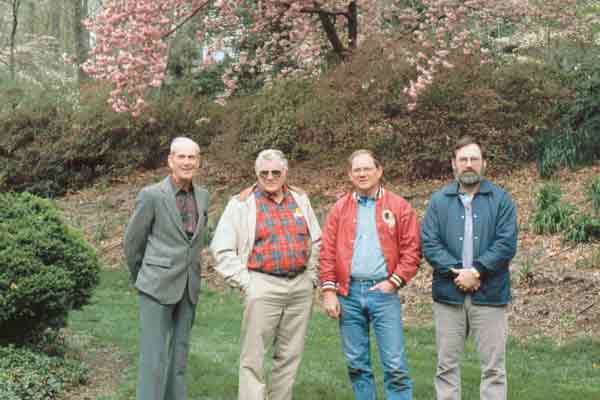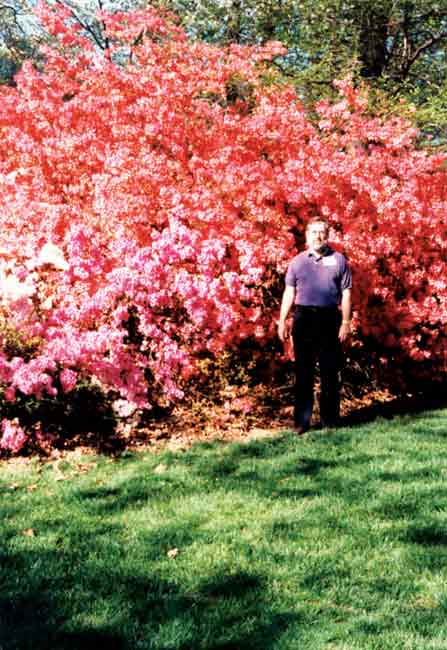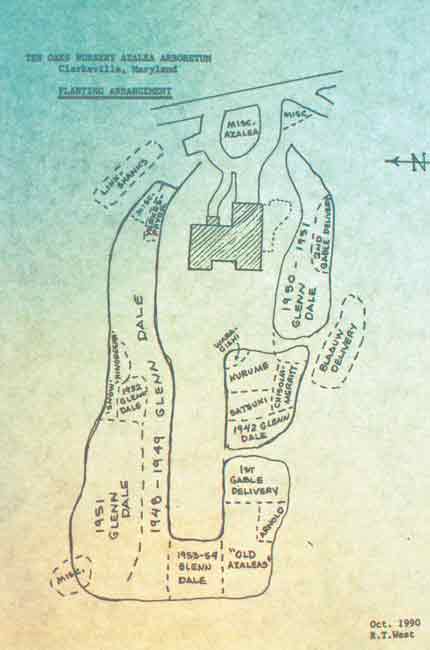JARS v63n3 - The Glenn Dale Azaleas: A History as Told by The Azalean, Part IV
The Glenn Dale Azaleas: A History as
Told by The Azalean, Part IV
William C. Miller, III
Bethesda, Maryland
This is the fourth in a series of Glenn Dale articles originally published in The Azalean, the journal of the Azalea Society of America (Vol. 15, No. 3, September 1993, pp. 56-57). This fourth article was a result of a slight course change in the Miller-West collaboration as we had heretofore focused primarily on the Glenn Dale Plant Introduction Station and the US National Arboretum. Dick West's interest in the Glenn Dale hybrids had led him to conduct an independent study of the Ten Oaks Nursery which he recognized as a major player in the Glenn Dale story. He had become good friends with Andy Adams, Jr. (the President), and had been given free access to the gardens and the nursery's records. The Ten Oaks Nursery and Gardens in Clarksville, Maryland was one of the three cooperating nurseries in Maryland that participated in Morrison's Glenn Dale distribution program - the other two being the Tingle Nursery Company (Leamon G. Tingle) in Pittsville on Maryland's Eastern Shore and the Kingsville Nurseries (Henry J. Hohman) in Kingsville, northeast of Baltimore. The Ten Oaks Nursery, about ten minutes from Dick's home in Columbia, Maryland, was a first-level recipient from the Glenn Dale Plant Introduction Station which meant there was increased confidence that the plants at Ten Oaks were correctly identified. Given the protected and undisturbed nature of the Ten Oaks property, the opportunity to study mature plants was unique. See the picture of 1.8 m (six ft) me standing next to a 6 m (20 ft) specimen of a forty-something year old 'Ambrosia'. Both Dick and I had a keen interest in "plant behavior," and we had often debated how many years one had to watch an azalea before it showed its true character - ten years, twenty years? Like the US National Arboretum, the "arboretum" at Ten Oaks was a living museum.
 |
| In Andy Adams' front yard,
at the Ten Oaks Nursery - (L to R) Dr. James B. Shanks, Professor Emeritus, University of Maryland; Andy Adam, Jr.; Dick West; and Bill Miller. Dr. Shanks was one of the developers of the Princess Series of azaleas, Andy Adams was doing the propagations, and Dick West assisted with the introduction and publication details (see The Azalean, Vol. 15, No. 1, March 1993, pp. 9-11 for information on the Princess Series). The photo was taken on April 22, 1991. Photo by Barbara Bullock |
Over the years, we had observed that the Glenn Dale hybrids were beginning to slip away and that
errors had crept into the market (e.g., 'Festive' and 'Geisha' were often confused and 'Satrap'
was routinely presented as 'Cinderella'). Glenn Dale hybrids in general were becoming increasingly
difficult to find and the number of nurseries who catered to the azalea collector was growing
smaller. In an effort to address the aforementioned problems, we devised a plan to give the Glenn
Dale hybrids a "second chance." With Andy Adams' approval, we proposed to redistribute the Glenn
Dales from the Ten Oaks Arboretum to a cohort of new cooperators who met certain criteria, and
we solicited interest in the concept in the March 1993 issue of The Azalean. The article that
follows is a more detailed account of the project and participants. It's important to note that
the article describes events and circumstances from 15 years ago. While I am aware that some
of the cooperators have since passed away (e.g., Freida Hill and Ben Reid), the list of cooperators
still serves as a useful starting point for pursuing an interest in the 454 Glenn Dale hybrids.
There were no images with the original article, and three images have been added for this
re-publication.

Bill Miller has published two books and many articles, has introduced four azalea
cultivars ('Seattle White', 'Landon Pride', 'Brookside Delight', and 'Bobbi Gail'), is a
life member of both the ASA and the ARS, and was recently re-elected president of the Brookside
Gardens chapter of the ASA.
The Ten Oaks Glenn Dale Project
Begins
Richard T. West and William C. Miller III
Columbia, MD and Bethesda, MD
Reprinted from The Azalean, September, 1993
The Ten Oaks Glenn Dale Project began in July 1993 with the first shipment of Glenn Dale
hybrid azalea cuttings to ten cooperators throughout the United States. The project was
announced in the March 1993 issue of THE AZALEAN (West and Miller III 1993). The purpose
of the project is to establish regional reference collections of the Glenn Dale azaleas
in addition to that at the U.S. National Arboretum.
Both of us have a long-standing interest in the Glenn Dale azaleas, and we agreed many
years ago that a complete collection of the 454 hybrids would be a valuable resource. We
knew that many others, including B. Y. Morrison, who was the director of the Glenn Dale
hybridizing program, had failed in trying to establish complete collections over the
past forty years, and we recognized that it would be harder now with many cultivars
being rare or perhaps lost altogether. Finding the unique collections of identified azaleas,
including a very large number of the Glenn Dales, at the Ten Oaks Nursery in Clarksville,
Maryland, made the goal of putting together complete collections much more feasible
(West 1989, 1992). In 1990, propagation began from the Ten Oaks stock to reconstitute the
Glenn Dales at the U.S. National Arboretum. We believed also that it would be good to have
Glenn Dale collections in other parts of the country to provide regional accessibility
as well as the duplication of reference collections. Additionally, we hoped it might be
possible somehow to assist in promoting commercial propagation to respond to the renewed
interest in acquiring Glenn Dales. The question was how to do these things.
 |
| The Glenn Dale 'Ambrosia' was
officially described by Morrison as "Erect and somewhat spreading habit, to 2.4 m (8 ft)." What most people don't realize is that this was the description for a ten year old plant. The opportunity to study forty year old azaleas in the Ten Oaks arboretum was unique and provided much insight into azalea behavior. The photo was taken by on a tour of the Ten Oaks Nursery on May 6, 1995. Behind the 1.8 m (6 ft) pink azalea in the foreground to the left is a 6 m (20 ft) tall specimen of 'Ambrosia'. Photo by Dr. Bob Hobbs |
We briefly considered expanding the propagation being done for the National Arboretum,
but we quickly realized that rooting cuttings and distributing plants on a larger scale
was beyond our capacity. Not being nurserymen and not being near Ten Oaks made what would
have been a replication, in effect, of the original U.S. Department of Agriculture's
Glenn Dale distribution program simply impossible in terms of workload and cost. However,
the substitute idea of a distribution of Glenn Dale cuttings did seem reasonable and doable:
by sharing the effort of distribution and propagation we thought it could work. The
announcement in THE AZALEAN stated, "We would like to identify a group of individuals
(cooperators) and (with the help of the cooperators) regional public gardens/arboreta around
the country that recognize the importance of this opportunity and that would be willing to
participate in the development of collections of Glenn Dale hybrid azaleas in their respective
regions." Interested parties were asked to submit a letter describing their facilities
and qualifications to undertake our proposal and to identify the reputable public garden that
had agreed to receive the plants. They were told that one specimen of each cultivar must be
given to the garden, but that they could do what they wanted with the rest, including
our hope they would be used as stock plants for further propagation for public sale. They
were also told that the only cost to them would be for shipping.
Ten cooperators have been selected for the project; they are, along with the designated
gardens:
1. Jan Bowman, Orinda, California, Oakland California Horticultural Gardens
2. Hugh A. Caldwell, Middleburg, Florida, Bellingrath Gardens
3. Perry L. Corkern, A & P Nursery, Franklinton, Louisiana, New Orleans Botanical Garden
4. Rick D. Ewing, Muskogee, Oklahoma, Muskogee Parks & Recreation Department, Honor
Heights Park
5. Freida Hill, Hill's Nursery and Greenhouse, Pavo, Georgia, Thomasville Garden Center
6. Ronnie D. Palmer, Azalea Hill Gardens and Nursery, Pine Bluff, Arkansas, Missouri
Botanical Gardens
7. Frank Pelurie, The Nursery at Dutch Ridge, Clendenin, West Virginia, West Virginia
Botanical Garden at Coonskin Park
8. Ben C. Reid, Stockbridge, Georgia, Vines Botanical Garden
9. Pete Sheuchenko, Barboursville, Virginia, Montpellier Estate Gardens
10. J. Keith Suddreth, Lenoir, North Carolina, Broyhill Walking Park
After making arrangements with the Adams family who own Ten Oaks, we began cutting
early on the morning of July 20 and finished in the early afternoon. We took between one
and eight cuttings from 57 Glenn Dale cultivars, put them in water for a while, placed
them in plastic bags with labels, and put the bags in a Federal Express box for each
cooperator. Each got some 300 total cuttings (average of five or so per cultivar), and
overall we took some 3,000 cuttings. For this first shipment, we chose to cut primarily
solid colors that had few sports, such as 'Snowclad' and 'Blushing Maid'. Next year and
later, we will remove sports from other cultivars before cutting or tag branches to
avoid cutting sports.
 |
| Andy Adams' back yard was in
reality the Ten Oaks azalea arboretum. This was where azalea acquisitions (including distributions from Glenn Dale) were planted in groups of three for further evaluation. The tags used by the arboretum were acid-etched lead and Dick West generally found that the tags were still there. As can be seen from the Dick West's diagram, the arboretum contained many rare cultivars from other hybrid groups. |
The azalea plantings at Ten Oaks have been essentially untouched for forty years.
In a few cases, plants are in poor shape, being overly shaded or crowded. Some
areas are a thicket of three metre (ten-foot) tall, intertwined branches. We took
what cuttings were available, which included using a stepladder at times or crawling
to follow a branch for three metres through other plants before cuttings could be
found. The good part of Ten Oaks is that natural growth can be studied and
documented, but the bad part is that high quality cuttings can be hard to get. The
boxes were sent to the cooperators by Federal Express overnight delivery.
We have stressed the need for the cooperators to verify the correct identity of
each cutting provided. The last thing we want to happen is the propagation of
incorrectly named plants. We have promised to replace any in-correct cuttings
as well as any that do not root. We believe the best philosophy nowadays is not
to trust anything in the marketplace, even those readily identifiable hybrids such
as 'Pixie' and 'Dayspring'. Accordingly, we will be shipping cuttings of all
identified Glenn Dales at Ten Oaks, in effect to rebuild collections from scratch.
For their information and to assist in verification, we have sent the cooperators
copies of B. Y. Morrison's, The Glenn Dale Azaleas, U.S.D.A. Monograph 20,
published in 1953, which is the official record of the Glenn Dale hybridizing
program and the hybrids produced. We have also sent them a color translation chart
that came from a Ruth Harrington article in THE AZALEAN in December 1988
to help with the old, and now mostly unknown, Ridgway color nomenclature used in
Monograph 20 (Harrington 1988). We appreciate that the issue of absolute color may
well be a problem.
We are pleased to say initial reports indicate that, on the whole, the first
shipment of cuttings worked out satisfactorily. Next year, if it is acceptable
to the cooperators, we plan to make two shipments, each of cuttings of 50 cultivars
for a total of about 600 to 700 cuttings of 100 Glenn Dale hybrids. We are keeping
records of what is cut and mailed with the idea of tracking the placement of plants
in the arboreta and gardens and of being able to direct interested parties to sources
of correct Glenn Dale material.
We wish to acknowledge that this project is possible only because of the azalea
collections at the Ten Oaks Nursery and the foresight of the Adams family, and,
notably, the encouragement and support of Andy Adams. It is the willingness of the
cooperators and gardens to be involved in developing Glenn Dale reference collections,
however, that will make it succeed. Progress reports will be published periodically.
References
West, R.T. and W-C. Miller III. 1993. Ten Oaks Glenn Dale Project. The Azalean
15 No.1: 16.
West, R.T. 1989. Distribution of the Glenn Dale Azaleas and the Ten Oaks Nursery.
The Azalean 11 No. 4: 69-73.
West, R T. 1992. The Azaleas at Ten Oaks Nursery: A Preliminary Report. The
Azalean 14 No. 3: 65-69.
Harrington, R. 1988. The Many Colors of Azaleas. The Azalean 10 No. 4: 73-75.
Dick West, a native of Washington, DC, is a long-time member of the Azalea Society and is interested in the Glenn Dale hybrids. He is a regular contributor to The Azalean.
Bill Miller is a former Vice President of the Azalea Society, co-chairman of the Membership Committee and chairman of the Public Information Committee. He is a member of the Brookside Gardens Chapter and has served as chairman of Horticulture for the chapter's annual flower show for many years. He is a frequent contributor to The Azalean.